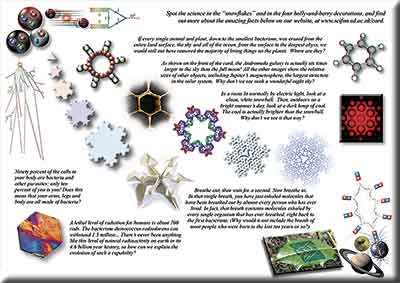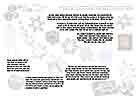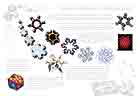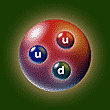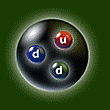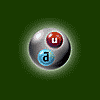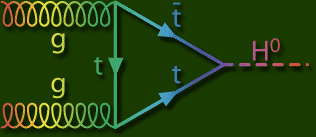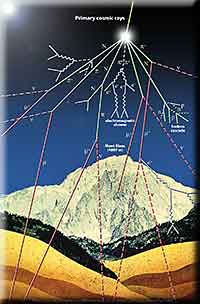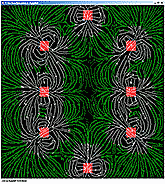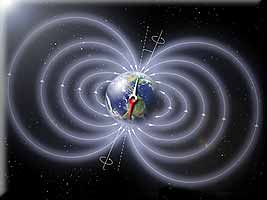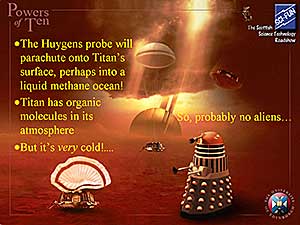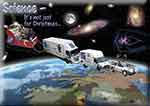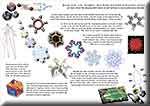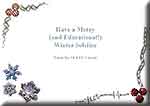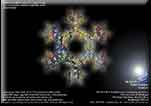|
SCI-FUN's Christmas Card
|
|
|
||||||
|
Amazing Facts
|
||||||
|
||||||
|
"Snowflakes"
|
||||||
|
||||||
|
|
||||||
|
Holly and Berries #1
|
||||||
| The images on the top-left of the page are the particle physics decorations: the berries are a collection of subatomic particles, and the 'holly' is represented by a variety of particle collisions and decays (see later). | ||||||
|
||||||
| The proton and neutron are the constituent parts of all atomic nuclei in the universe. Until the middle of the last century it was believed that they were fundamental particles (although it was known that free neutrons decayed into a proton and electron), but gradually we began to suspect that there was an underlying structure to these (and many other) particles.
Current models suppose that the proton and neutron are made up of three quarks, which come in a variety of different types, as illustrated in the diagrams below. [The Wikipedia articles on quarks and particles are worth reading.] A third particle is shown: a pi meson (or pion), one of the products of the collision of cosmic rays with the atmosphere. (See below.)
|
||||||
| It's now suspected that the proton may not be completely stable, although current estimates are that it takes on average over 1032 years for a proton to decay, which is about 10,000,000,000,000,000,000,000 times longer than the lifetime of the universe...
(Interestingly, we can be sure that the proton's lifetime has to be greater than 1017 years: you have around 1027 protons in your body, and if the proton lifetime were this short you'd be highly radioactive...) A watch dial painter in the early twentieth century (when radium-based paints were used for glowing numerals, and the painters licked the brushes to point the tips) turned out to be so radioactive through ingestion of radium that doctors were able to expose a radiograph of her body on film using only her own radioactivity, and her breath caused phosphor screens to glow brightly... (She didn't survive for long, in the company of many of her co-workers.) |
||||||
|
|
||||||
|
Holly 1 – The Higgs Boson
|
||||||
|
The Higgs boson is the particle which (if it exists) gives other particles their mass, and whose existence was predicted by Professor Peter Higgs, formerly of Edinburgh University. The Higgs boson has not been experimentally confirmed... yet.
A brief (and somewhat clumsy :-) description. [The following should be read with an accompanying soundtrack of creaking thin ice...] When two protons from the opposing LHC streams are forced to pass close enough to each other (the protons effectively collide and overlap), an interaction takes place between the constituent parts of each particle. In particular, two gluons (the carriers of the colour force, which binds the quarks tightly together inside the proton), represented by the spring symbols above, interact by fusing, creating a temporary virtual fermion loop, in which a top quark (the heaviest of six quark types) can be thought of as circling around the trianglular path. We never detect the quark directly: it's an intermediate state in the production of the Higgs particle. We can think of the arrow for the anti-top quark as being a top quark pointing in the other direction, so that the loop could be redrawn to show a t in anti-clockwise circulation (created out of the energy of the gluon fusion). Writing the anti-top as above does, however, make it clearer (!!) that the virtual loop ceases with the production of a neutral Higgs boson, by the annihilation of the top and anti-top quarks, the resulting energy being great enough to cause the boson to be created, which itself then rapidly decays. It's the decay products of the boson that we will look for in the collision data from the CMS and ATLAS experiments at CERN. The PP4SS page will soon have more information and images from our recent trip to CERN, where we visited some of the LHC experiments, currently under construction. |
||||||
|
|
||||||
|
Holly 2 – A Shower of Muons
|
||||||
|
Some of the end-product particles are muons, which can be detected at sea-level, thanks to Einstein's Special Relativity theory, and the bizarre behaviour of objects travelling near the speed of light. Our PP4SS page will include a full description of this property, in our "muon lifetime" experiment... (more soon). (Note: the π symbols in the diagram refer to pions, one of which (the π+) is one of the 'berries' above. As you read this sentence, products of cosmic ray showers such as this are sleeting through your body, occasionally causing bits of cell damage, which are (mostly) repaired. |
||||||
|
||||||
|
Holly and Berries #2
|
||||||
|
Click here to visit a web page with a fascinating Java applet *, which simulates in real time the interactions of magnetic and electric fields, and allows you to generate the holly pattern. Click on the image opposite to see one attempt to produce the field shape, using the program. * The applet was written by Paul Falstad, a software developer in California. He has lots of other interesting science applets (and links to other pages) at his main website, www.falstad.com. |
||||||
| Question 1: I used many more magnets than necessary to produce the holly pattern. Can you work out how to make almost exactly the same pattern (with the same number of spikes, for example), but with far fewer magnets? | ||||||
|
|
||||||
| The Geomagnetic Field | ||||||
|
Any mechanism for the field has to take into account its periodic reversals over time. More accurately, the dipole (bar-magnet) component dies away, leaving the non-dipole field (the wibbly-wobbly high-order spherical-harmonic type bits), then grows again with the opposite polarity. (What was North is now South...) [Open University kipper tie mode ON:] And what happens when the field reverses? Execrable films such as The Core notwithstanding, the disappearance of the main dipole field won't lead to the end of the world. (There's no evidence that reversals are connected with previous extinctions, since the non-dipole field would still keep most external particles away, although a chaotic period of time would ensue (and some aspects of human society would be altered). Anyway, there are a few thousand years to go, at least...) * "magnetohydrodynamics" is actually a word. (I was accused of making it up...) It's the study of fluids which carry a current (and can therefore sustain a magnetic field). |
||||||
| Question 2: If a compass points its North end towards the Earth's 'North' pole, what does this tell us about the polarity of the pole at the, er, North pole? (Don't confuse this North pole with the North pole where Santa used to be supposed to live; it's a different North pole. (Santa lives in Lapland now, where the post is better.)) | ||||||
|
|
||||||
| Saturn and Titan | ||||||
|
The Huygens probe was successfully detached from Cassini, and parachuted down to a safe landing on January 14th 2005! Click here to go to the ESA site, to see some of the extraordinary images returned by the spacecraft. during its descent and landing. An outstanding European success, and a wonderful example of scientific collaboration. |
||||||
| Running out of inspiration (and time), I eventually found a picture of a real Holly leaf. Er, and that's about it... apart from a tiny factoid: holly wood is particularly dense, with a compact texture. It's often stained black and used as a substitute for ebony when making black piano keys. | ||||||
|
Remember to check out the Amazing Facts and "Snowflakes" pages |
||||||

